
November 2023
In this edition
- CEO update
- John Gransbury is retiring
- The importance of communicating with your bank
- Harvest update
- 2023 Tasmanian Young Water Professional of the Year - Isaac Probert
- People development workshops planned for summer 2024
- Employee value proposition (EVP)
- Next Generation Breakthrough - 2024 SA and Tasmania programs
- Containment feeding support for tactical decision making in dry times
- Management of vineyards after fire damage
- Foundations for success - free webinar
- Harvest photo competition
CEO update
Welcome to this edition of InTouch.
Last weekend two of our three 35,000L rainwater tanks went dry. I always keep one tank quarantined just in case something happens. Given this, I flicked open the gate value and reset the pressure pump and we were away again. The last time this happened was in 2007 and it was much later in summer. I then reflected on the season in Clare and recalled we hadn’t really had a lot of rain. Actually, it hasn’t rained for months. I then looked up the CliMate App and looked up the Jan – Nov rainfall for Freeling. To November 9, we are 152mm below our median rainfall. Annual rainfall for Freeling is the sixth lowest since the year 1900. This is a recurrent theme across many clients nationally.
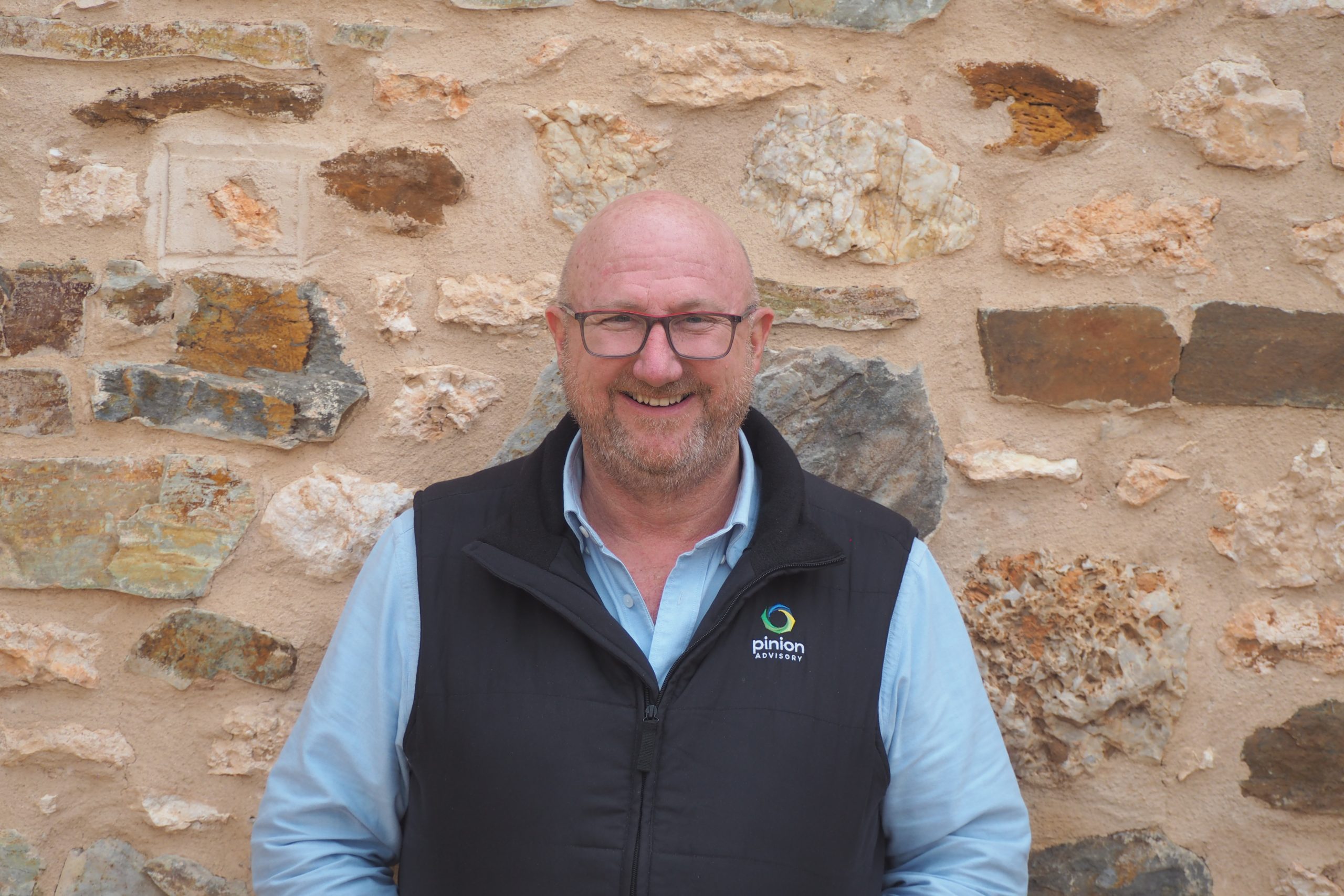
I then reflected on the crop yields that are currently being harvested and celebrated the effectiveness of our farming system and the technical advice we receive to optimise our gross margins.
The year has also been compressed. Last year’s late harvest and this year’s early seeding put a lot of pressure on many clients. Many have managed this well, but many have cracks. There is a lot of talk about the importance of resilience. Resilience is defined as “the capacity to withstand or to recover quickly from difficulties.” In many respects, resilience is reactive. I prefer to be proactive and forward looking. Given this, I prefer to advocate 'stamina'.
Stamina is the ability to prolong physical and mental effort. In any business, it is accepted there will be good times and not so good. Managing this business cycle requires a level of physical and mental fitness that can be developed by any farm and business owner. Building stamina requires intentional physical and mental training, ongoing skills development, support and rest. I am hopeful many clients can take the opportunity to reflect on the year and rest. Some business stamina building goals for 2024 can also be developed.
Currently, we have some exciting projects happening within our business. We also have some great opportunities for clients emerging in 2024.
We have some notable staff announcements to share, as John Gransury is retiring after an impressive 45 years of service. I want to take this moment to extend my congratulations to John and, on behalf of the team, wish him all the best in his well-deserved retirement. Shifting gears, it's always a delight when a team member's hard work is recognized. In that spirit, we are excited to announce that Isaac Probert, a Graduate Water Engineer, was recently honoured as the Tasmanian Young Water Professional of the Year at the Australian Water Association annual dinner in Hobart. Congratulations, Isaac fantastic work!
I would also like to take this opportunity to thank you for your support this year. On behalf of the Pinion Advisory team, we wish you and yours a very Merry Christmas and a safe and happy New Year!
John Gransbury is retiring
John Gransbury
After 45 years of designing irrigation and water systems, it's time I put down the tools.
I was the former owner of HydroPlan, which along with Rural Directions, Sunraysia Environmental and Macquarie Franklin, merged to form Pinion Advisory. It was a perfect fit for the HydroPlan business and 20 staff at long-term offices in Perth, Adelaide, Sydney and Brisbane. With over 12,000 commercial ‘pump and pipe’ systems in 30 countries, the diverse mix of urban and rural applications brought geographical spread and an opportunity to expand the services offered to clients. Water is critical, whether growing plants in the city or the paddock – but scale, drivers and risks are wildly different.
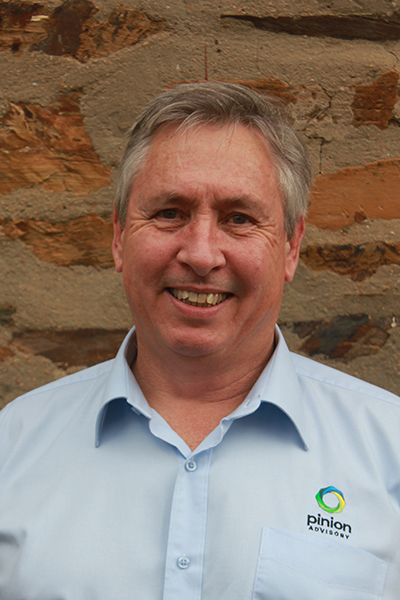
Born in Keith and raised on a prime lamb and beef property near Kuitpo Forest, my passion for good design came from an artistic mother and an inventive father who challenged his five sons over the dinner table with problems like, ‘is it quicker to fill a tank from the top or bottom’. I graduated as a civil engineer from University of Adelaide in 1979 and developed my passion for water when designing large drip systems in Jordan, Kuwait, Iraq and Egypt for three years. During the next four years in Australia and Asia, designing systems for vines, cotton, sugar cane, mangoes, and kiwifruit etc, I saw the need for independent design services, and started HydroPlan in Adelaide 37 years ago.
Like any business, it is hard work and hard on family, but despite this I’m blessed with five gorgeous girls – two daughters, two granddaughters and a wife who deserves all the credit. I had a partner in Perth for 12 years, a partner in Sweden for four years, many partners in Optimatics for 22 years, and 9 to 12 partners in Pinion for two years, so now my ‘life partner’ and I will get to spend some quality time – and I get to fix the home irrigation system!
I’ve loved designing and building useful water systems. It’s so rewarding, and more so when the owner really gets the nuances. I’ve learned what ‘great’ looks like, and I’ve loved it when my colleagues trump me with better ideas than mine – like the way we used genetic algorithms to minimise energy and choose from multiple water sources for a 1,400km stock and domestic pipeline to 330,000ha and 12 towns, including Ararat.
What we achieved on Bunyip Water was crazy good; fast tracked over 100 construction contracts, saved a $30m crop by lifting 410 million litres of wastewater and bore water up a 220m hill using three manual diesel pumps in-line (no tanks) spread over 26km, running a team of uni students and backpackers to pump 24x7 for three months, so we could finish the original scope on time, under budget. It’s delivered 2,000 million litres per annum since 2016 and is now being expanded to harvest stormwater from urban development. I got an ‘Honor’ award in Seattle from the American Society of Irrigation Consultants, and all stakeholders shared an industry award – quite a buzz.
A month ago, the Willunga Basin Water scheme celebrated 25 years and 100 billion litres of treated wastewater distributed to vineyards around McLaren Vale. Having completed a self-funded community pipeline for Langhorne Creek, I was asked to engineer a private pipeline from the Christies Beach wastewater treatment plant, through suburbia, to vineyards. The owners had 17 outlets, but then we helped expand it every year to over 250 outlets, which serve 65% of vineyards. The scheme was the role model for the Wamuran Irrigation Scheme commissioned on the Sunshine Coast this year, and I was the ‘Solution Architect’.
While I am very proud of my involvement with many fantastic projects, I am more proud of our team’s capability and their capacity for ongoing delivery of innovative water solutions for clients across Australia. While I am retiring, clients will continue to be in very good hands.
To all those people out there that have allowed me to enjoy my career so much – thank you!! I’ll be around to help my awesome colleagues if they need me (probably won’t). I’m not going anywhere anytime soon; I’m just not doing timesheets anymore!
The importance of communicating with your bank, particularly during a downturn
In years where everything is ticking along nicely, spasmodic communication with the bank is okay. If, however, commodity prices are low, and seasonal conditions aren’t favourable, then more regular communication with the bank is advisable. Ideally, this should be a two-way street, the bank should be communicating early as well.

All farming enterprises go through ups and downs. A couple of current examples of downturns are the winegrape and livestock sectors. In both cases, the sooner the conversation starts with bank the better.
Bankers don’t like surprises, and nothing strikes fear in an agri-banker more than logging onto their system in the morning and seeing an overdrawn account notification. This sets off a domino effect of internal reporting within the bank and is, ultimately, not a good look for the client.
The better option is to be on top of the numbers and cashflow, and contact the bank before the cash crunch hits. An even better option is to flag any potential issues before you know for certain that cashflow will be an issue.
Those businesses that keep a tight rein on their income and expenses and, importantly, the timing of both, will be best placed to provide accurate and timely information to the bank. Agri-managers enjoy working with farming businesses that operate professionally in all aspects of their business.
Farming businesses that are in the middle of a downturn for whatever reason, will more than likely require extra financial support to see them through. Banks are more than happy to provide this, but they do want to know the reasons why, and whether the business has mitigated risks as best as it can, and how long the extra support is going to be required.
Of course, no one has a crystal ball and knowing when things will turn around is a bit of a guessing game. But the good agribusinesses would have done the research and presented this information to the bank, in addition to updated budgets etc.
In the case of livestock producers, it seems that the fundamentals are still okay for the industry, but there is certainly a downturn in prices currently, and this is having a major impact on profitability and cashflow for producers that are in the livestock sector.
Banks are interested in how much livestock are selling for in the current market, but they do take a long-term view of prices for agricultural commodities. All banks do it a bit differently, but many banks will use a seven-year rolling average of prices to determine the viability of an agricultural enterprise.
An example was the conversation I had with a client recently, where he said that his income was going to be much lower given the current low livestock prices, and he was concerned the bank would take a dim view of this. I said that given the banks use a seven-year average, the bank will view the current prices as an aberration. They know what the long-term average is, which is higher than current prices being received.
Banks have been lending to agriculture for over 150 years, and they do understand the vagaries of farming, and that there are certain things that can’t be controlled by the agribusiness owner.
Another aspect that banks highly value are businesses that seek quality professional advice. For instance, if a livestock producer used the SnapShot benchmarking service from Pinion Advisory, this would give them relevant information on how well their livestock operation is going, and what are the changes that will have the biggest impact on profitability.
For instance, in a livestock enterprise there are multiple ratios that are measured in a benchmarking report, such as:
- Livestock income per hectare
- Livestock variable costs
- Livestock gross margin
These are all vital pieces of information to know about your business, and it allows you to show the bank just how well you are performing against industry standards. It also gives a trend analysis, that would most likely show that the current returns are an anomaly compared to the historical and projected performance of the livestock enterprise.
Other ratios that SnapShot track is around pasture utilisation, stocking rates, average turnoff weights, reproduction rates, fleece value (where relevant), and various financial metrics. The point being, there is a plethora of relevant information that the farming business can use to determine its own performance, and demonstrate to the bank that the business is on top of its numbers, and knows where room for improvement is.
Banks love data, and the more relevant information you can show them the better. Also being on the front foot in relation to communicating potential issues will stand the business in good stead in securing extra funding, or gaining flexibility from the bank to ride out the temporary decline of revenue into the business.
Please reach out if you would like to discuss finance options for your business, or how harnessing the power of SnapShot benchmarking will help improve your profitability.
Email: mbagshaw@pinionadvisory.com
Mobile: 0409 793 946
Harvest update
Across the southern region, some headers are getting their first taste of the 2023 harvest, whilst others are done with their duties and parked back in the shed ready to roll out next year. A season incomparable to the last, harvest conditions have been near perfect for many regions with crops ripening earlier than usual and harvest running close to three weeks ahead of schedule.

Up until the back end of last week, where we saw a significant rainfall event cross eastern Australia, which then made its way south west, there had been no hold up on harvest due to weather. Leading up to the forecast rainfall, concerns regarding grain quality following the rainfall event escalated, which ultimately highlighted the potential support for both lentils and protein wheat prices. However, keeping in mind the dry and testing season Southern Queensland and Northern NSW faced, harvest is largely complete north of Dubbo. The focus is now on the summer crop, which has been set off with an abundance of moisture in the soil profile in QLD and NSW. Ultimately this is likely to put pressure on feed prices across the country.
Locally, grain quality is high this year with more malt around, however there are also mixed grades coming into the system due to the dry finish and late season frosts.
Harvest pressure, has it kicked in? The gradual increase in harvest activity had little effect on price. It is thought the trade's tonnage expectations were higher than the actual supply, and although prices have weakened from where they were prior to harvest, they have remained relatively stable. Particularly for wheat and barley, prices have held their ground relative to other commodities. As for barley, the removal of the Chinese tariff has increased demand and prices have risen accordingly. The dry finish has seen higher protein wheat flow into warehouses, but many are happy enough with what the season produced and are breathing a sigh of relief.
Pulse crop quality has been good, however, with lower yields caused by the dry finish, particular sites have been supportive as buyers look to cover shipping positions. However, lentils are volatile due to shipping and destination demand. Similarly, whilst the quality of beans is good, yields are 20-30% below expectations. This will tighten the S&D to the supply side.
There has been more buying demand than selling pressure as growers see current prices for particular commodities, such as canola, too cheap. Prices are likely to remain sideways until the grower sells, however weak prices don’t help the trade secure tonnes and, at some point, they will need to engage the grower with competitive prices. At particular port zones with limited sellers, it is the perfect recipe for a price rise.
Look to fill tonnage to contracts along with continued post-harvest sales in small parcel sizes to manage cashflow and position risk. There are good opportunities still to be had and maybe even an opportunity for a break this year!
Congratulations Isaac!
The Pinion Advisory team is thrilled to share that Graduate Engineer, Isaac Probert, has been named 2023 Tasmanian Young Water Professional of the Year.
Isaac, a civil engineer, joined Pinion Advisory in mid 2022. Working from Hobart, in our water engineering team, he contributes to projects ranging from private farm infrastructure, through to regional water schemes for clients such as Tasmanian Irrigation. On the weekends you might find him volunteering with the SES or paddling a kayak on a Tasmanian watercourse.
Pinion Advisory currently employs nine graduates (from a workforce of 100 this is an impressive stat!) across our agribusiness, water and environment teams. We love working with early career professionals and helping them grow fantastic careers. If you, or someone you know, is interested in a career within Pinion Advisory reach out to us.
Isaac will compete for the National Young Water Professional Award at OzWater’24 in Melbourne. We all think he would be a worthy winner!
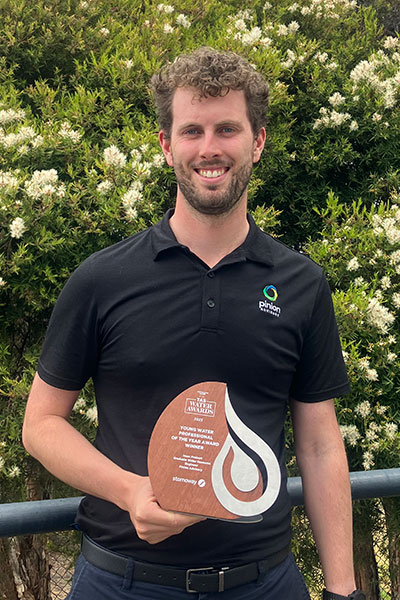
People development workshops planned for summer 2024
We have a series of online workshops kicking off next month. These include:
Farm HR: Creating Employers of Choice
Group 1: 23, 30 January & 6 February 2024
Group 2: 8, 22 February & 7 March 2024
This workshop is for those new to HR management or wanting to brush up on their HR knowledge.
Topics covered include job descriptions, overview of FairWork and the Pastoral Award, culture and creating compliant and motivating wage offers.
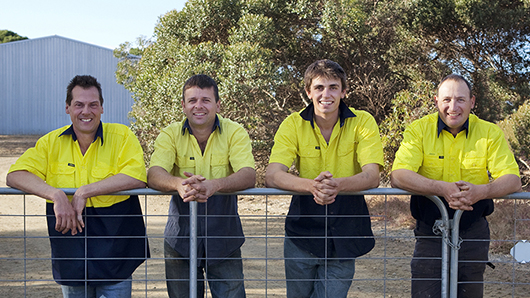
“It’s a valuable and holistic view on employment. Well worth the time”, Jeremy Lush
“Do the course if you are employing or about to employ. Gives you a great overview”, Scott Manser.
Strong Foundations
12, 13 & 14 December 2023
7, 14 & 21 February 2024
Online course delivered over three sessions via Teams
A valuable add-on to the farm HR course is the Strong Foundations workshop series. As our relationships within extended family, work and home are complex and occasionally contentious, Strong Foundations is aimed at helping you better navigate connection, communication, leadership and stress.
“Insightful and instantly effective” Suse Ifould

Employee value proposition (EVP)
The agricultural industry has experienced increased demand for labour in the last few years. Employers are looking for strategies to stand out in a very competitive employment market. We don’t just compete with other farms; we also compete with other industries.

In the past the focus has been on employers striving towards being an 'employer of choice'. Although still valid, this is an employer-driven focus. There is a need to deepen this approach and ensure the focus is on employees. Explore what employees value and develop connections based on these values.
Focusing on employees is defined as employee value proposition or EVP. This is defined as the value offered to employees by their employer. In return for these values, employees offer their skills, experience and commitment to the business. This is an exchange of value.
Earlier this year, Pinion Advisory surveyed employees and employers to gain insights into EVP and how businesses can boost attraction and retention outcomes.
Key findings included:
- Half of employees have been with their current employer for at least six years. This is longer than the national average of 56% of those employed have been in their role for less than five years (abs.gov.au).
- Six out of ten of employees are not looking to change jobs. But four out of ten employers have a current vacancy in their team. This shows that demand for employees remains strong and very competitive.
- Aspects employees ‘love’ most about their current job include the work team, training, good machinery and role flexibility. These aspects need to be fostered by employers looking to attract and retain employees. Aspects that might have been viewed as benefits are now shifting to expectations or minimum entry requirements.
- Most employees told us they loved their job but there were a few areas identified as common dislikes. Aspects employees ‘loathe’ in their current job include poor communication and work hours during peak periods. These need to be explored within each business to ensure expectations are managed.
- The average satisfaction and motivation scores for employees was 7.8 out of 10. This was a strong result and shows that most farm employees really love their jobs.
- As expected, employees who are not satisfied or motivated in their current roles are looking for new jobs. There was a spread in employees in this position, from years working in the business and type of role. It appeared satisfaction and motivation issues can occur in all roles and stages of career.
- Value alignment is strong between employers and employees. The three most aligned values were honesty, integrity and teamwork. These are a great foundation to develop a working relationship from.
Our report provides more details on these points (and many others). The report provides practical insights on what is needed to improve attraction and retention outcomes. It will change the game for those looking to stand out from other employers.
If you would like to know more about employee value propositions, you can order a copy of the report here.
Next Gen – 2024 program (SA & TAS)
2024 will see the start of another Next Gen Breakthrough program. Now is the time to get involved.
This program has benefited many farming families and business teams. Here are a few of their comments after completing the three-year program.
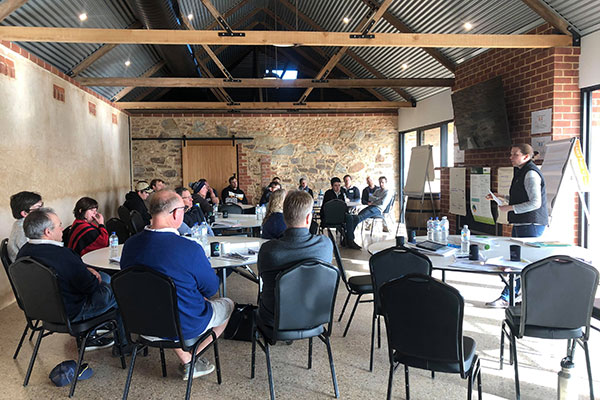
- “Communicating better, instilling leadership and culture. Planning and empowering our boys, making good contacts”, Chris Collins.
- “Improvements in business knowledge for my family team. Financial, culture and people management”, Ian Sparks.
- “Most useful is having mentors part of some of those tricky succession sessions to help implement progress and change. Business cases, benchmarking, different personalities were all very useful”, Jaimee Button.
- “Once you feel like you have a handle on the general running of the business, don't hesitate to sign up, it will provide you with more knowledge, and tools to improve your business more than you could ever imagine”, Bryce Chapman.
Working with the support of your mentor, sessions will focus on management succession and planning for the future. You will build your capacity in business management, financial literacy and personal leadership.
In 2024 there will be two groups starting, one in SA and one in Tas.
For more information, please call Carlyn Sherriff on 0439 773 688 or visit Next Gen Breakthrough Group.
Containment feeding support for tactical decision making in dry times
In drought conditions or times of reduced pasture growth, containment feeding can be a valuable tool to supplementary feed stock while removing the grazing pressure on dormant pastures to maintain ground cover and reduce erosion risk.
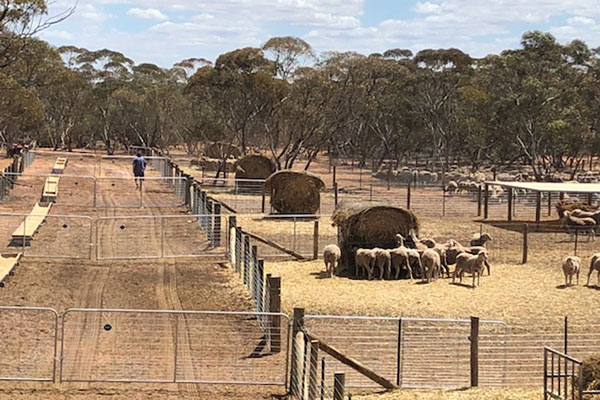
With many regions of southern Australia experiencing a dry spring and continued dry weather forecast for the summer ahead, decision making about setting up containment feeding is likely to be on the minds of many producers. Pinion Advisory consultants, Georgia McCarthy (Tasmania), Lauren Rowlands (Tasmania) and Nathaniel Modra (South Australia), with support from the Tasmanian Farm Innovation Hub and MacKillop Farm Management Group, have undergone specialist training and will be providing one-on-one support to producers who are interested in developing a plan to set up a containment feeding system, or are looking to improve on an existing set up.
Introductory workshops will be held in Tasmania and the south-east region of South Australia over summer (dates and locations to be confirmed). Workshops will aim to:
- Connect producers from the same region with an interest in implementing or improving containment feeding options for sheep enterprises.
- Increase the knowledge, confidence and skills of producers to make informed decisions around containment feeding, including suitable designs, nutrition and feed requirements, animal health and water requirements.
- Highlight the value of completing a plan to support producer decision making about containment feeding systems.
Following these workshops, attendees will have the opportunity to access support and work one-on-one with a Pinion Advisory consultant to develop an individual containment feeding implementation plan for their business, outlining the best suited system for their enterprise, in addition to nutrition and ration assistance.
Containment feeding workshop dates and locations for Tasmania and South Australia will be confirmed shortly and registration will be essential as places are limited. If you are interested in attending and accessing further support with implementing a containment feeding system for your sheep enterprise, please contact one of the following consultants.
Georgia McCarthy, Livestock Consultant (Tasmania)
M: 0400 763 904
E: gmccarthy@pinionadvisory.com
Nathaniel Modra, Agribusiness Consultant (Naracoorte, SA)
M: 0438 640 768
E: nmodra@pinionadvisory.com
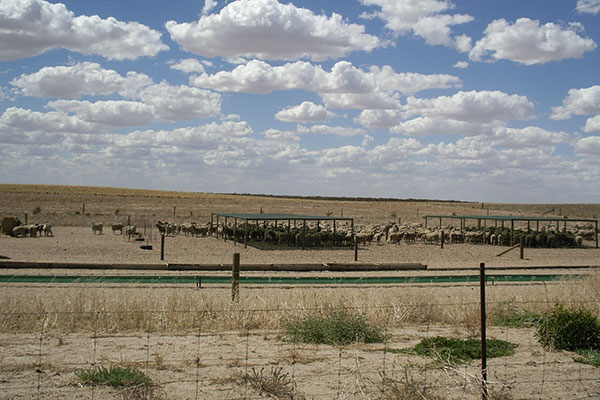
Management of vineyards after fire damage
On December 20, 2019, the Cudlee Creek Bushfire burnt through 25,000ha of the Adelaide Hills. 1,200 hectares of vineyards were damaged, representing approximately 30% of the Adelaide Hills Wine Region plantings. The fire damage to vines ranged from scorched leaves to charred trunks.
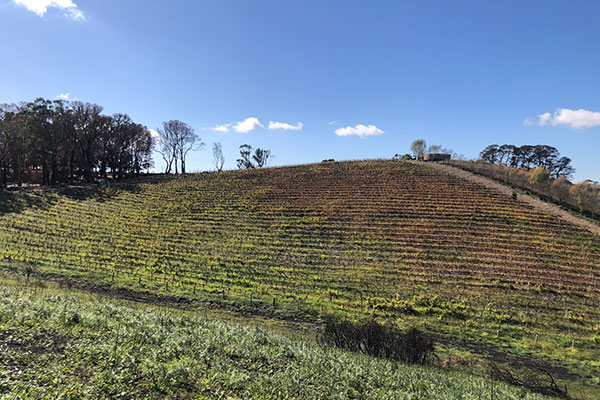
The dilemma growers faced immediately after the fire was to determine what actions should be taken to optimise vineyard recovery and which management options would be most effective, based on the level of fire damage observed. Viticulturists, Colin Hinze (from Pinion Advisory) and Richard Hamilton, partnered to undertake research over a three-year period to answer the following key questions should this scenario eventuate in the future.
- What is the best practice timing for remediating moderate to severely damaged vines?
- What is the best winter pruning method for vines recovery after fire damage?
- What is the most cost-effective recovery strategy to return to productivity?
Three separate trial sites were established and managed within commercially operated vineyards over the trial period – two of which were side-by-side demonstration sites, and the third was a replicated trial. Economic data was collated from eight separate grape growers that were affected by the Cudlee Creek bushfire.
The key recommendations from the project are:
- Reinstate irrigation infrastructure as soon as possible to provide water for stressed and damaged plants.
- Do not act early – wait and observe the natural regrowth of the vines to gain a full understanding of the magnitude and distribution of damage.
- Critically assess the vineyard’s viability, profitability and other production issues before committing to expensive remedial activities.
- After fire damage and before winter dormancy, leave all regrowth in place (no vine training) and maintain operation management (irrigation, pest control and fertiliser) to maximise vine health and the winter storage of carbohydrates for the following season.
- Where vineyards have sustained only minor and moderate damage, spur pruning is the most effective and economical option for return to production.
- Trunk replacement should only be considered for three scenarios:
-
- Where vine damage is severe,
- Where variability of damage will impact future vineyard uniformity, or
- Where other (pre-fire) vine health or infrastructure issues have been affecting the viability of the vineyard.
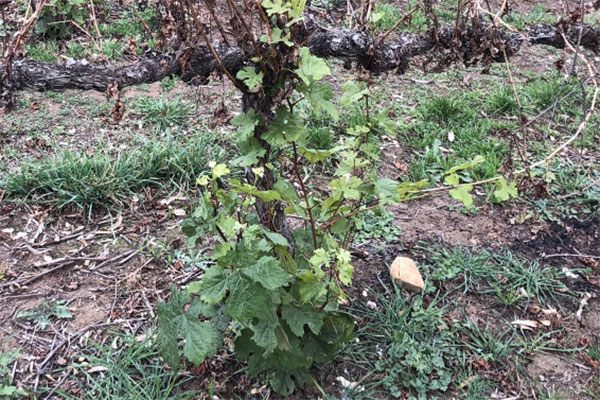
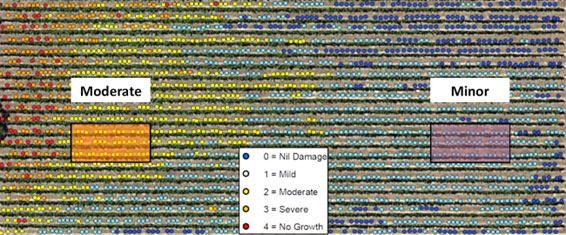
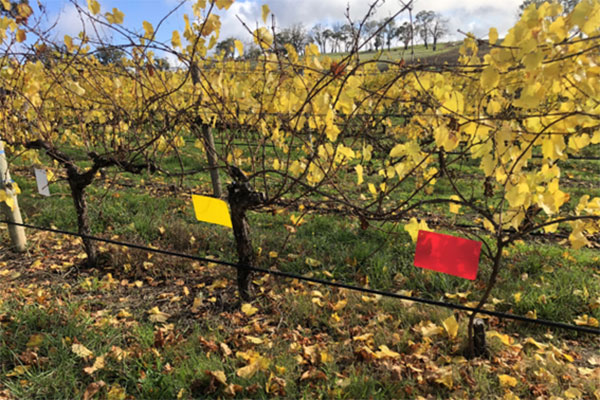
This project has shown that the intensive treatments of conversion to cane pruning and trunk replacement do not provide an overall economic benefit for the first three seasons after the fire, even for moderately damaged vines. It is only in areas that have been severely damaged, where there is no or limited re-growth from the existing cordons, that the practice of trunk replacement is justified, unless there are other advantages (e.g., cordon decline and trunk disease management).
This project has been supported by Wine Australia in partnership with the Department of Primary Industries and Regions (SA). This Local Economic Recovery project was jointly funded by the South Australian and Australian Governments under the National Disaster Recovery Funding Arrangements.
We are grateful for the input and support of the Adelaide Hills grape growing community for this project with, particular thanks to the growers that hosted and supported the demonstration trials.
Foundations for success – free webinar
Experiencing frustration in a relationship at home or on farm? How we talk to each other, beliefs we create, and our automatic anger-response is usually to blame… and that’s all fixable. Join Bron as she provides insights and strategies that can greatly improve relationships and wellbeing.
Watch the YouTube for a couple of key insights Bron shared at a recent Livestock SA webinar.
If you like to hear more, you can register for a Strong Foundations online workshop.
Harvest photo competition
Send in your best harvest photo from this season for your chance to win a pair of Apple AirPods (2nd generation) valued at $219.
Simply click the link below to email your photo and include your name, contact number and the location of the photo*. Easy!
*By submitting an entry, you give permission for Pinion Advisory to use your photo for promotional purposes.
